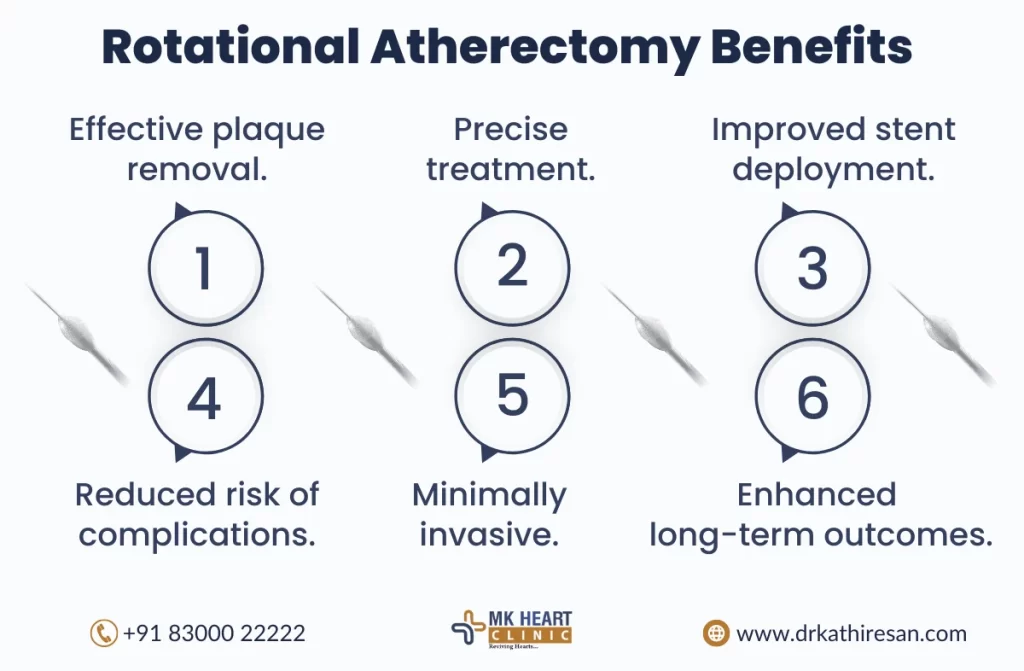Rotational Atherectomy (Rotablation) is a minimally invasive procedure used to treat calcified and heavily stenosed (narrowed) coronary arteries. It involves using a high-speed rotating diamond-coated burr to shave off the calcified plaque and clear the artery lumen, improving blood flow to the heart.
Typically, the rotational atherectomy treatment in Chennai is performed in combination with balloon angioplasty and stenting, and is performed through a catheter inserted through the femoral artery in the leg.
This procedure is used in patients with complex coronary artery disease who are not suitable for traditional angioplasty, and has been shown to be effective in improving symptoms, reducing the need for repeat procedures, and improving long-term outcomes.
Cause of Rotational Atherectomy Treatment in Chennai
The primary cause of these calcium deposits is the build-up of plaque, which is made up of fatty substances, cholesterol, and other substances.
Over time, this plaque can harden and restrict the flow of blood to the heart, leading to chest pain (angina), heart attack, and other heart-related issues.
This is where rotational atherectomy treatment in Chennai is performed using a rotating burr or diamond-tipped device to break up the calcium deposits in blood vessels, particularly in the coronary arteries besides restoring normal blood flow to the heart.
Who is the Right Doctor for Rotational Atherectomy?
Dr. M. Kathiresan, a renowned cardiologist specializing in rotational atherectomy treatment, is the right doctor to consult in Chennai. With extensive experience and expertise in this advanced cardiac procedure, Dr. Kathiresan offers comprehensive care to patients seeking effective treatment for coronary artery disease. His commitment to excellence and patient-centric approach make him a trusted choice for rotational atherectomy in Chennai.
Diagnosis
Diagnosis of the need for rotational atherectomy treatment in Chennai is typically done through a combination of medical tests, including:
- Coronary angiogram.
- Intravascular ultrasound (IVUS).
- Computed Tomography (CT) angiogram.
- Stress test.
Based on the results of these tests, a doctor can determine whether a rotational atherectomy procedure is an appropriate treatment option and which vessels may need to be treated.

Treatment
The rotablation procedure is performed by an interventional cardiologist and typically takes 1-2 hours. It is performed in a hospital or outpatient setting using local anaesthesia and mild sedation.
During the rotational atherectomy treatment in Chennai, a small incision is made in the groin or wrist to allow access to the affected coronary artery. A catheter is then inserted into the artery and guided to the site of the calcium deposit. The area around the calcium deposit is prepared for the procedure.
This may involve injecting a dye to visualize the blood vessels and using imaging equipment to guide the rotablation device consisting of a rotating diamond-tipped burr, which is activated and used to break up the calcium deposit. The fragments are then removed from the bloodstream through the catheter. The patient’s vital signs and heart function are monitored during the procedure to ensure there are no complications.
After the procedure is performed, the catheter is removed and then the incision is closed. The patient will be monitored for a few hours to ensure there are no complications. Recovery time after rotablation is typically short, with most patients able to resume normal activities within a few days.
Rotational Atherectomy Procedure
- Local Anesthesia: The patient is usually given local anesthesia at the insertion site, often the femoral or radial artery.
- Guidewire Placement: A guidewire is threaded through the blocked artery under X-ray guidance to reach the location of the plaque.
- Rotational Atherectomy: The rotational atherectomy device, equipped with a rotating burr, is advanced over the guidewire to the site of the blockage.
- Plaque Modification: The rotating burr grinds and modifies the calcified plaque, creating small particles that can be easily carried away in the bloodstream.
What is the Normal Success Rate for this Procedure?
The success rate of rotational atherectomy, a procedure used to treat calcified coronary artery blockages, can vary depending on individual patient factors and the complexity of the case. In skilled hands, this procedure can be highly effective in improving blood flow to the heart. It’s essential to consult with a specialist like Dr. M. Kathiresan in Chennai to assess your specific condition and discuss the expected success rate and potential risks.
Benefits
Rotablation is a minimally invasive procedure used to remove calcium deposits from the coronary arteries and improve blood flow to the heart. Some of the potential benefits of rotational atherectomy treatment in Chennai include:
- Unlike traditional open-heart surgery, rotablation is a minimally invasive procedure that does not require a large incision or general anaesthesia. This can result in a faster recovery time and fewer complications at an affordable rotablation angioplasty cost.
- By removing calcium deposits from the coronary arteries, rotablation can improve blood flow to the heart, reducing symptoms of angina and reducing the risk of heart attack.
- The results of rotablation can be long-lasting, with many patients experiencing improvement in symptoms and blood flow for several years after the procedure.
Risks
However, there are also potential risks associated with rotational atherectomy treatment in Chennai. They include:
- Infection/bleeding.
- Damage to blood vessels or surrounding tissue.
- Heart attack or stroke during or shortly after the procedure.
- Arrhythmia or irregular heartbeat.
- Allergic reaction to contrast dyes or medications used during the procedure.
Rotational vs. Orbital Atherectomy: Choosing Effective Treatment in Chennai
When considering atherectomy for coronary artery disease, understanding the differences between rotational and orbital atherectomy is crucial. At leading cardiovascular centers in Chennai, like ours, both options are available.
Rotational Atherectomy
- Involves a high-speed rotating burr to remove plaque.
- Effective for calcified lesions.
- Offers precise control during the procedure.
Orbital Atherectomy
- Utilizes a unique orbital motion for plaque modification.
- Well-suited for concentric lesions.
- Provides controlled, differential sanding for optimal results.
For personalized atherectomy treatment in Chennai, consult our expert cardiovascular team.
Facilities
Some of the technology and facilities that are typically used during a rotational atherectomy procedure:
- Rotablation device.
- Angiography or intravascular ultrasound.
- Catheterization laboratory.
- Local anaesthesia and mild sedation.
- Monitoring equipment.
- Recovery area.
Our Doctors
Dr. Kathiresan gives a comprehensive rotablation atherectomy treatment at a reasonable rotablation angioplasty cost. He helps to evaluate the patient’s condition, determine if rotablation is a suitable option, and oversee the procedure besides discussing the potential benefits and risks of the procedure with the patient. Moreover, he monitors the patient’s progress during and after the procedure to ensure a safe and successful outcome.
Also, Read Orbital Atherectomy Treatment in Chennai.


